Among the Lizard People
Silent Connections at the Reptile Expo
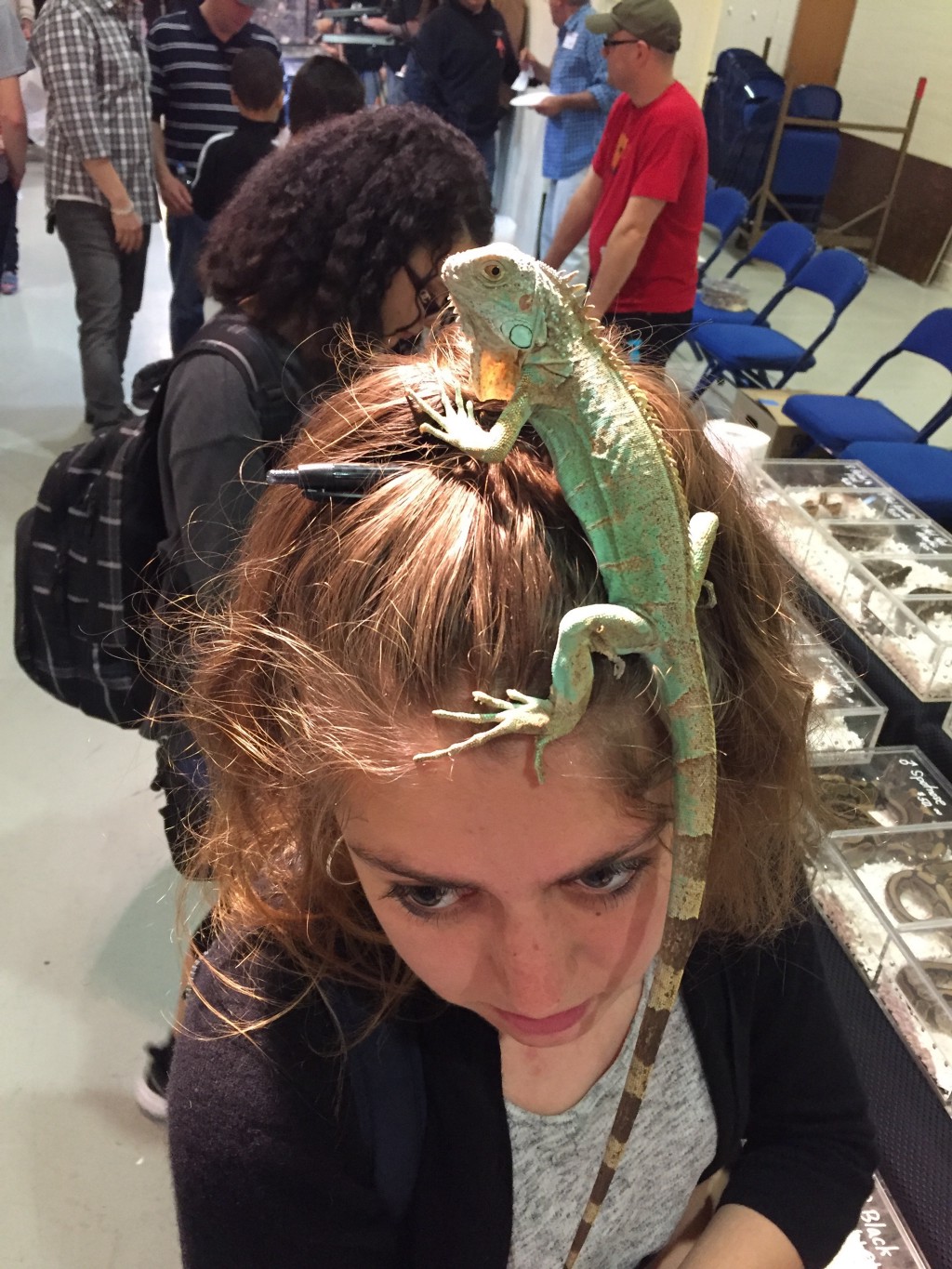
On April 17th, about eight hundred people made their way down to the Westchester County Center for the White Plains Annual Reptile Expo. The entrance resembled a music festival: men in food trucks called out to the masses while others tried to peddle T-shirts and freeze-dried crocodile heads. The back seat of the Jetta next to mine was packed to the roof with grasshoppers. Ten dollars and one hand stamp gave access to a high school-like gymnasium with booths packed so tight you had to squeeze past something scaly just to get a corn dog. The air was thick with the scent of mealworms and formaldehyde, and the faint sounds of dated pop music.
Pets are generally owned for company; they’re surrogates for human interaction. The appeal of dogs is clear: It’s natural to crave the heat and weight of a body, even if it’s furry. Dogs are responsive to their owners, and have an unspoken fondness for them that’s evident through nuzzling and cuddling. But a reptile will not nuzzle. It will not purr or retrieve a tennis ball. At its most serene, a lizard won’t interact with you any differently than it would a branch. It’s a strange thing to keep a creature you have no hope of developing a relationship with.
There was a crowd around a very tiny man selling very tiny frogs. The frogs were spectacular, about the size of a piece of popcorn with a splattering of colors, each a mini Pollock. “Gorgeous,” a woman said, as though browsing the counter at Tiffany’s. Another vendor pushing seven-thousand-dollar crested geckos told me he’s sold to everyone from Jean-Luc Godard to Tony Hawke.
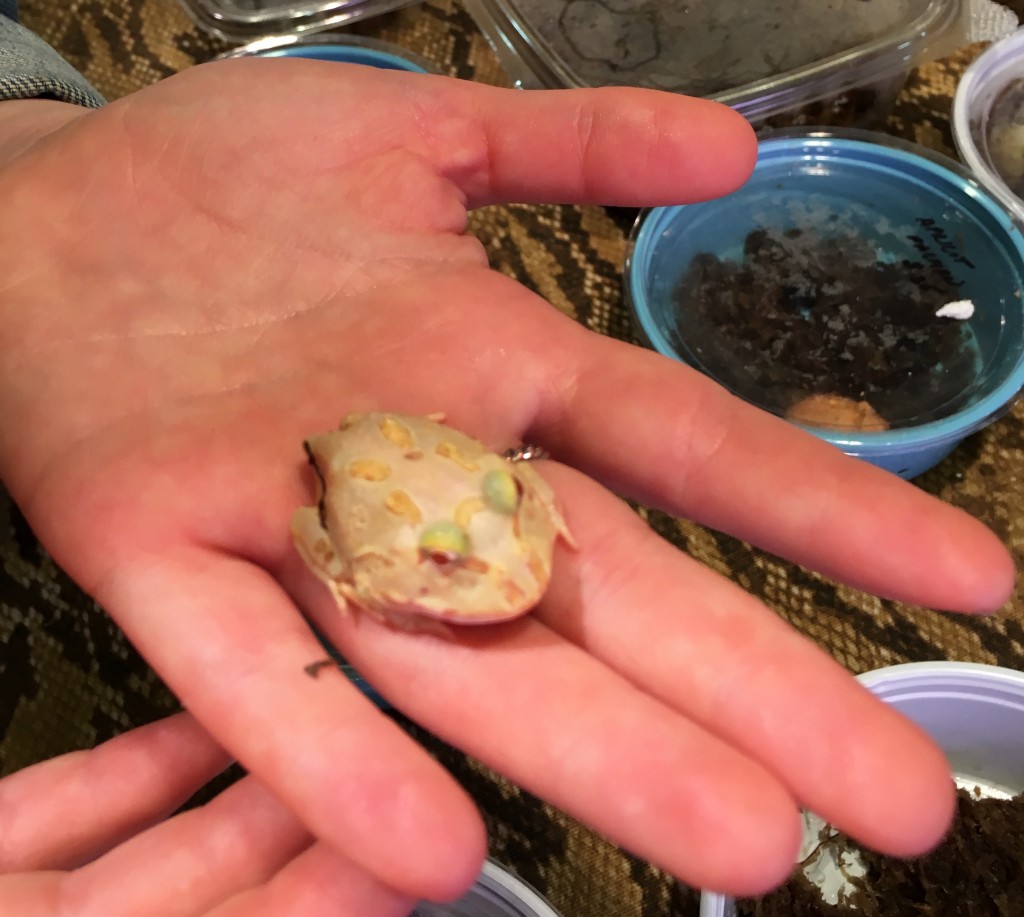
Amy the peppy representative at a booth called SnakeLand, looked to be in her late forties. She smiled, revealing two rows of bubblegum-pink braces. Snakes covered the table’s surface, each balled up and crammed into the kind of container I’ve only ever seen chicken tenders served in. One of the boxes was not for sale.
“Yeah, that’s my guy.” Amy said. “The breeder. He’s just here for show.”
She picked up the snake, a milky yellow Python about as thick as a roll of toilet paper, and draped it around her neck like a scarf. “He hangs out with me while I do the dishes or laundry. He’s like a scaly puppy dog.”
The corn snake vendor was a skinny man in the midst of a sale. Two girls passed a wisp of a snake back and forth and murmured to each other. Feeling the match was right, they finally asked him the snake’s gender.
“I’ll check for you,” he said reluctantly.
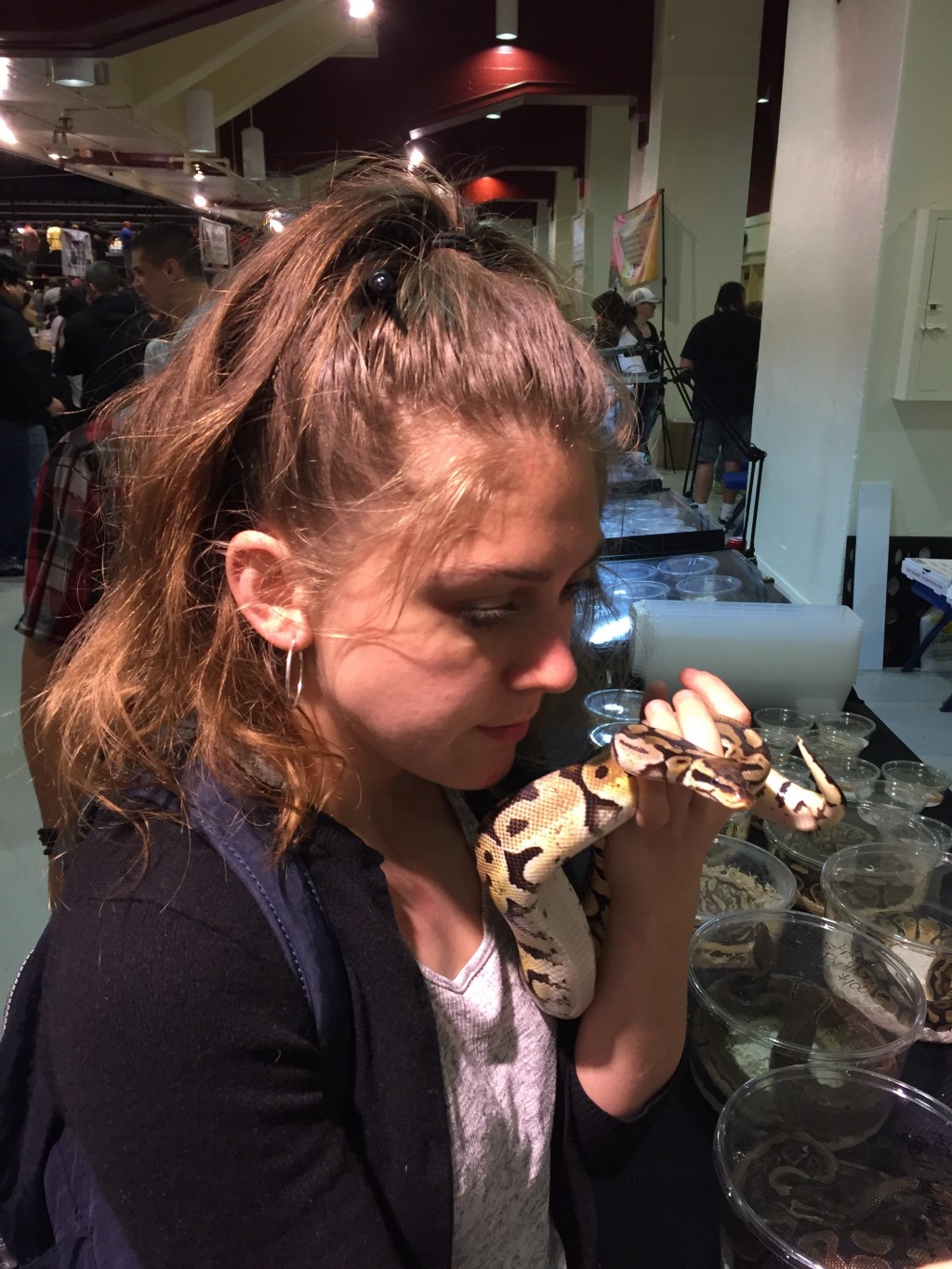
I leaned in closer as the man flipped the snake over and began rubbing back its scales. They parted ways to reveal a small slit no thicker than a thumbnail. The man turned a deep shade of red.
“Uh-oh, it’s female.” He put it down. “I — I have to go wash my hands.”
He ran off, leaving us alone with the aroused corn snake. One girl leaned over to the other, “For God’s sakes, it’s just a snake vagina.”
The Tortoise woman stood statue-still behind her booth, dressed in a long coat with a ruffle collar and tiny circular spectacles. Many of the vendors had a particular look, and hers appeared to be 1880s Prussia.
“How big can these guys get?” I asked.
“Up to 18 pounds.”
I asked her how she got into tortoise breeding.
“I got my first male and female four or five years ago and purchased an incubator soon after.”
“I mean what inspired you to get the turtles in the first place?”
“Tortoises,” she corrected, but didn’t seem to have an answer for me. What I really wanted to ask was why she’d chosen the least enthusiastic pets on the planet to dedicate her time to.
“My daughter graduated from USC last spring.” She did what any empty-nester would do; started breeding land tortoises.
As a child, I had debilitating dog and cat allergies. During my parents’ lengthy separation, my father got me Spike, a Bearded Dragon, in lieu of a puppy. Spike became my confidant for all of first grade. I talked to him for hours, pushed him around in my Barbie car, and cuddled him at night until his body temperature got too low and he had to go back under the heat lamp. When he got mad or stressed out, flaps of skin would protrude from his neck like a Shakespearean ruff. I can still picture Spike’s knowing look. His mouth started under each eye and stretched across his whole head in what I interpreted as a coy smile. He just got me. Then Spike got a metabolic bone disease and died. My parents divorced, my dad got a new wife and a golden retriever, and I got an inhaler.

Lunchtime for humans was 12:00, and for reptiles, 12:30. I reached into a large ice cream cooler to discover it was packed with frozen rodents. There were rats and mice, some large and come small and fetus-like, packed popsicle-style in Ziploc bags. The most alarming were the frozen guinea pigs. Huge, eyes open, mouths contorted, and paws out as though they’d been petrified mid-leap. What could possibly eat something so big, I wondered.
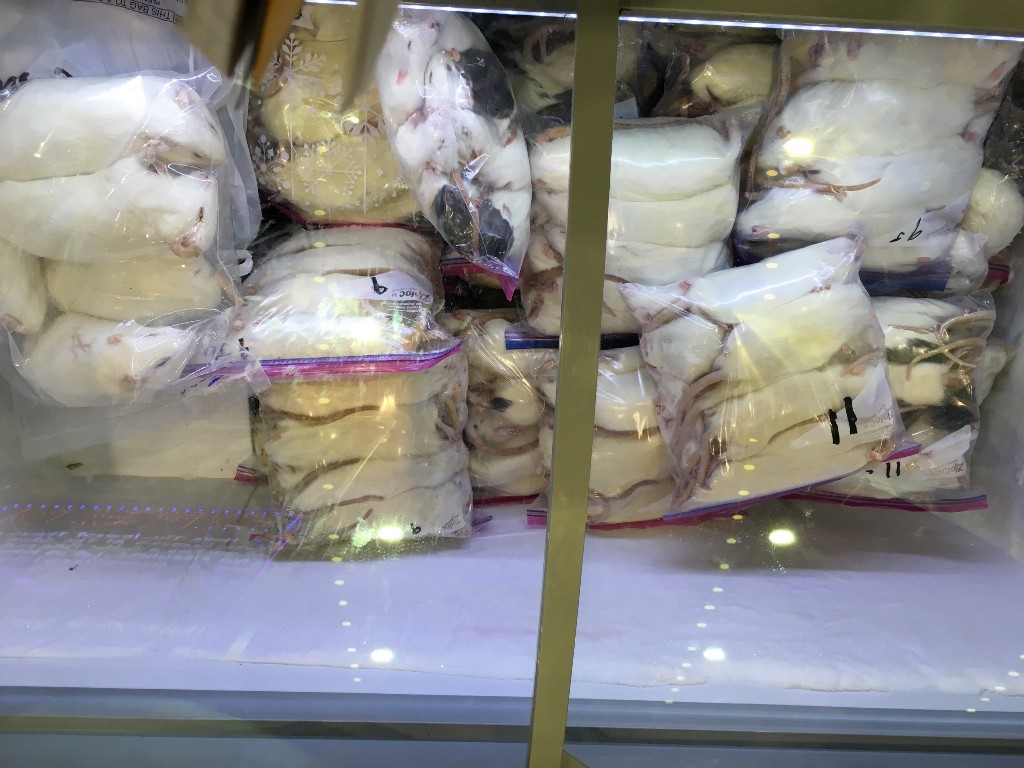
Nelson was not in a chicken-tenders container but a steel cage. According to the fact sheet next to him, he was 15 years old and weighed 25 pounds. He looked like he could have been an extra in Jurassic Park. His great legs and jaw were not those of a lizard but of some primordial fish monster in the throes of evolution.
“He can live up to 45. Longer with the right care and a healthy diet.” Nelson’s owner boasted.
In the cage there was what appeared to be an untouched salad. A jar next to him was raising money for his care. The jar was filled with twenties. Nelson was going to outlive us all.
“He’s quite friendly,” explained the owner as the lizard lusted after a juicy toddler in the booth next door. I asked her how she came to have Nelson.
“He came to me, really.” Of course, this was impossible, unless she was wandering around the jungles of the late Cretaceous period. She took me aside to elaborate. “My son lost his battle with cancer years ago, and I didn’t know what to do with myself. My time had been consumed with helping him for so long, and then nothing. I was going crazy. Then I saw an ad for a young Rhinoceros Iguana that needed a home. Nelson needs lots of care, so I started to feel useful again. We don’t have much money, so we come to these things to fundraise. Yup, he’s my guardian angel.” She smiled.
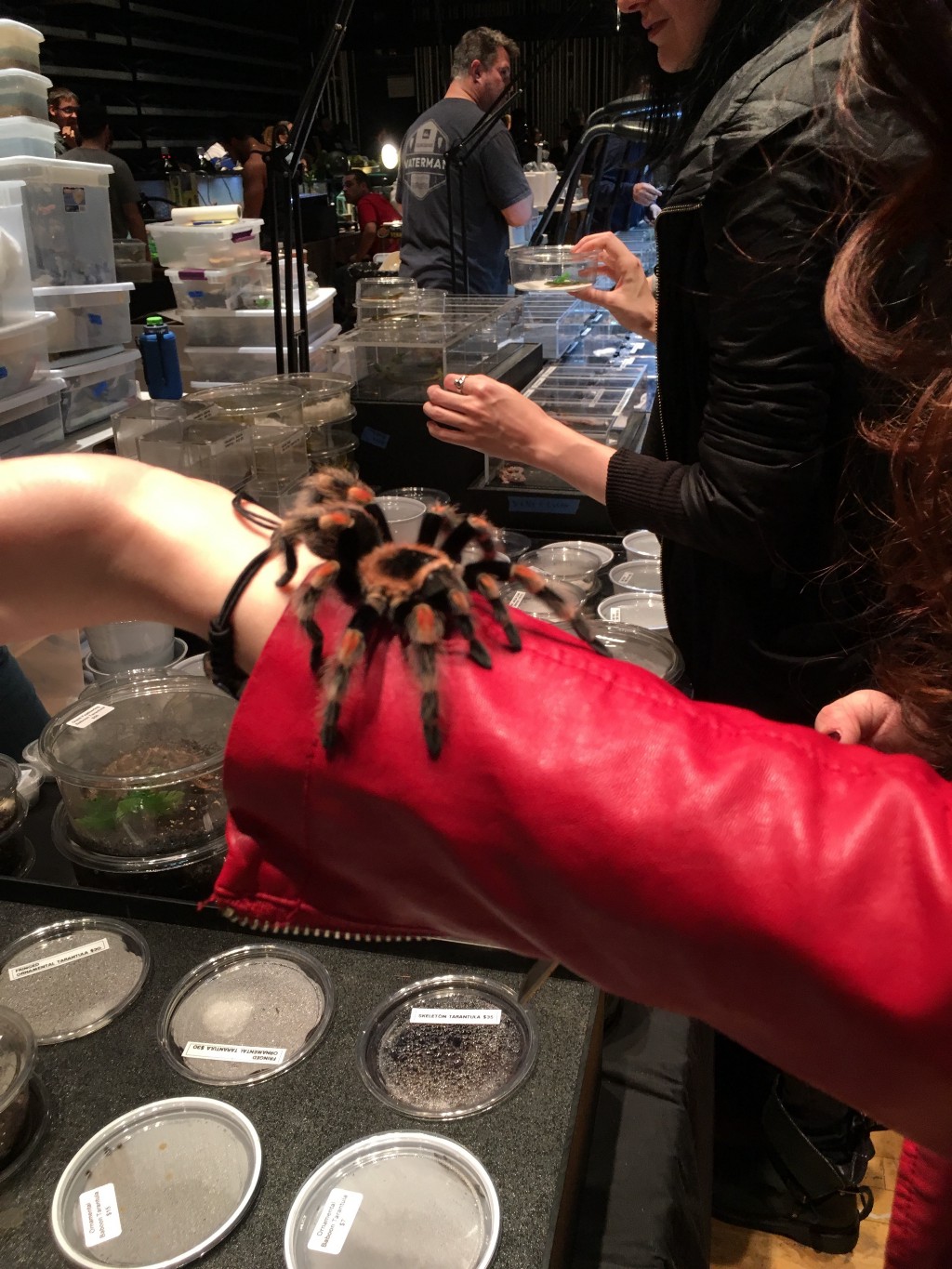
The solace I once took in Spike, that unspoken connection no one else could understand, which maybe didn’t even exist, echoed all over the Convention Center. A lizard’s inhuman qualities are its appeal. They are whatever you need them to be—loving, smiling, a good listener — because the relationship is all a projection. The creatures there that day, the Spikes and the Nelsons, were like fork-tongued therapists, sitting there listening in unsettling silence.
When I saw the Bearded Dragons, my heart swelled. The gold-breasted beasts had the same long mouths carved across their faces that, as a child, I’d understood to be a smile. The vendor handed one over in an attempt to make a sale off my nostalgia. It cocked its head up at me with that permanent grin and it all flooded back. He looked just like Spike. And he was not determining whether I was a giant cricket or not, he was looking into my heart, my lonely childhood soul that didn’t understand separation or divorce or cat allergies any more than he did. The way his warm belly pressed against my palm and his nails caught in the fabric of my shirt was so familiar. His owner, a stocky woman wearing a man’s blazer over a shirt depicting a bedazzled outline of the state of Texas, told me his name was Cinnamon. She saw my growing affinity for the creature and gently recollected him into the booth.
“He’s $150,” she said
“I had one when I was younger that looked just like him. It’s uncanny.”
“Just like him?” Cinnamon’s owner scoffed. “Cinnamon has very distinguishing spots on his back, see, here. Most Pogona Bearded Dragons don’t have markings like these.”
I nodded, feeling foolish that I hadn’t noticed before.
“He just sort of feels like my old lizard, you know?”
She didn’t and it was time to move on anyway. It was feeding time for a neighboring boa constrictor and I didn’t want to miss it.
